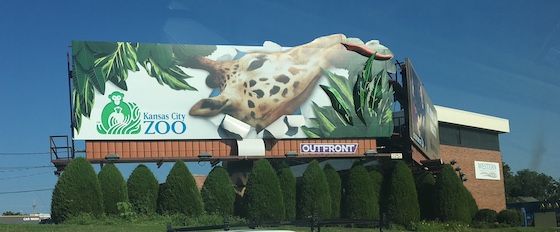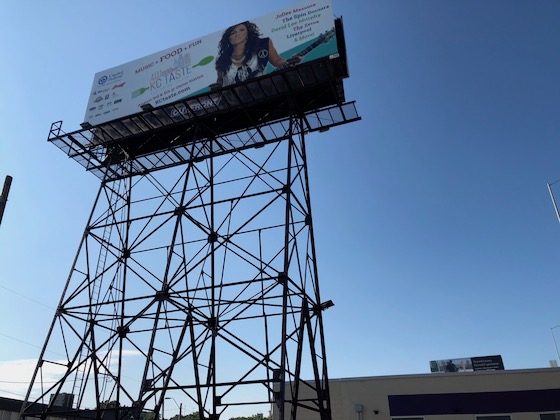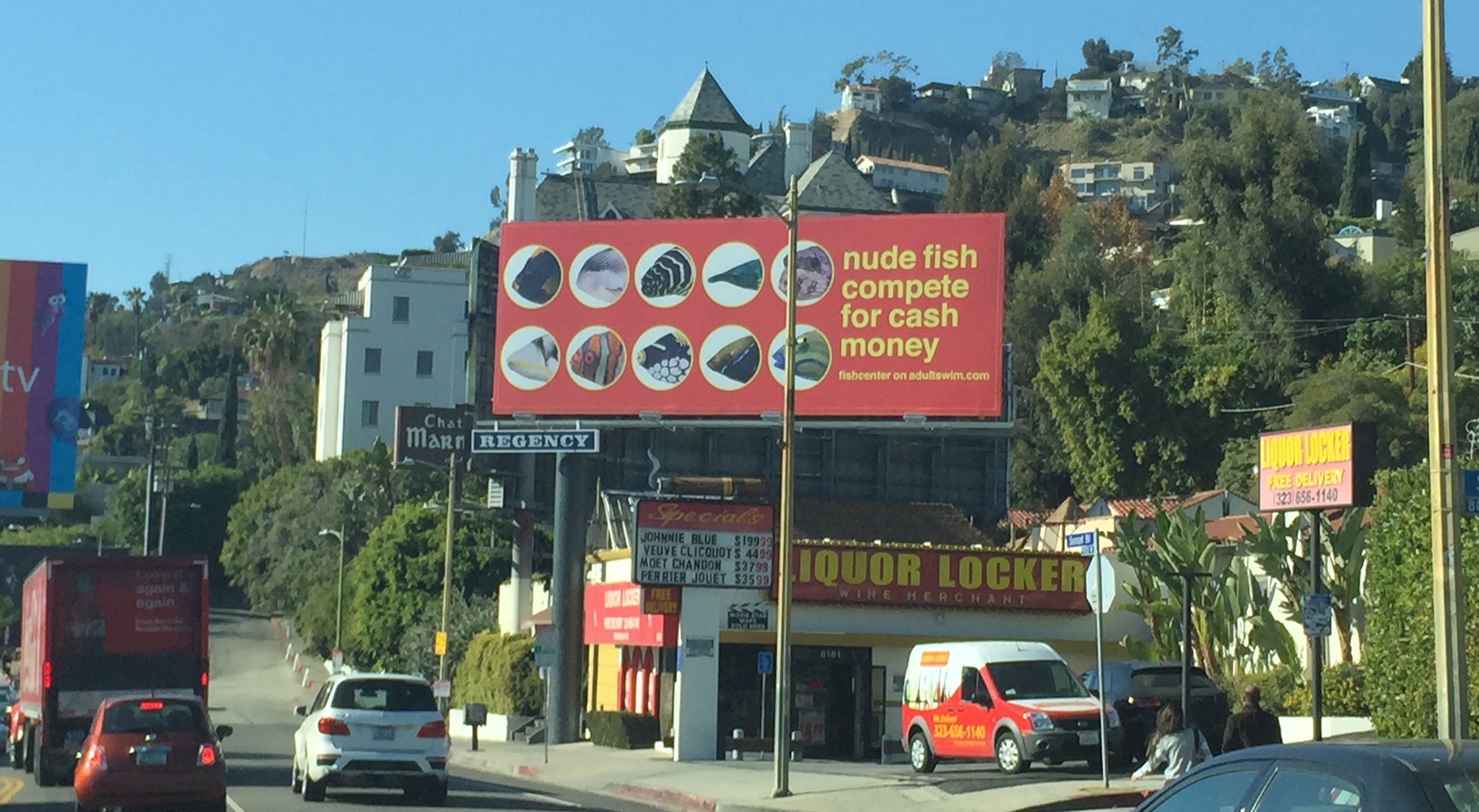Memo From Frank
The Holiday Season is the one time of year in which billboards get serious competition from holiday decorations. For the entire rest of the year, the only thing to look at while driving down the road are billboard signs. Then, for about a month, there’s a competitor in the form of bright Christmas lights on many houses and buildings. Of course, the Holiday Season also rewards billboard owners as most businesses do their highest amount of sales during this period, and that gives them money to rent billboards the rest of the year.
I would like to take this opportunity to extend a hearty “Happy Holidays” to all who read this newsletter every month. I have great fun in writing it and producing the photography and am proud that we remain the only billboard newsletter in the industry. So grab a glass of eggnog and read this final version for 2018 and we’ll be talking again in the New Year!
A Little Extra Effort Makes Even The Ugliest Billboard Attractive

Nobody has ever said that billboards are aesthetically beautiful (although they are really not that bad, contrary to what some environmental groups say). But there are methods to make even the least attractive signs blend in with their environment better. And that will lead to a happier land owner.
Block the view of the poles
The first trick is to hide the poles from view. At the lowest end of the spectrum, you can paint them brown or green so they don’t stand out so bad. At the highest level, you can wrap the poles in brick or reflective mylar, or block visibility by erecting a fence or barrier.
Add landscaping
Another option is to simply grow something up the pole or poles, such as bushes or vines. This helps the sign appear as a part of nature, and is far less expensive than building something to hide the poles. The drawback of this plan is that you have to choose some type of plant that does not require irrigation.
A professional shield
The nameplate on the sign is called the “shield” and a professional-looking one sends a message that the sign is proudly owned and maintained. You can build a great shield at FastSigns (or similar group) our of aluminum and vinyl lettering. Or, if you want to go to the next level, you can make it backlit with internal lights and wire it into the sign’s power source.
A nice-looking ad
Of course, when most people talk about a billboard being “ugly” it’s not the sign structure they’re talking about – it’s the ad on it. That’s why, if you have an upscale location, it’s essential that you seek out a quality advertiser like a bank or car dealer and not a burger joint or a political ad.
Conclusion
Nobody likes an ugly sign. But there are steps you can take to make any billboard better looking. This list will get you off on the right foot.
Why You Can Take On Big Billboard Companies...And Win

The U.S. has some large billboard companies such as Outfront, Lamar and Clear Channel. Some of these are even publicly traded on the stock exchange, and own hundreds of thousands of sign faces. But even the person starting out can take on and beat these companies for many reasons. Here’s how you can beat out big, established sign companies.
Faster speed
Big companies have many decision makers, and there’s a problem when you have “too many chefs in the kitchen”. The end result is that it takes forever to make decisions by committee. Since most land owners hate to wait around – it’s actually insulting – they prefer people that can make snap decisions. And nobody can make a decision faster than a one-person company.
Less costs equals higher lot rent ceiling
Big companies cost a lot to operate. There’s a ton of employees, expensive office space, and a bunch of executives. As a result, their cost of operation is many times that of the smaller operator. This means that the smaller operator can make money on a lot smaller spread between the ad rents and property lease than the larger one. The bottom line is that the small company can pay more land rent and that’s one of the strongest reasons that motivates land owners in their selection.
Bonding
“Bonding” is when the property owner and the billboard company owner become friends. This is simply not possible with big companies. As a result, most small companies have a definite advantage when it comes to winning the lease based on personal friendship. I’ve actually had land owners tell me “you’re offer was not as high but I like you better”.
Most people hate big businesses
It’s a given that most Americans hate big businesses. They have a natural aversion to them based on past experiences where they felt they were not given the right respect or attention. Think of your own run-ins with airlines or your cellular phone company – it didn’t make you feel too warm and fuzzy did it? This means that the small operator actually has a natural advantage on the big company – you’re not actually starting off as the underdog.
Conclusion
Small operators can definitely take on big operators and win. The cards are not stacked against you. Every big company in the U.S. began with one single sign.
The Ultimate Billboard Boot Camp
![]() How to Find a Billboard Location
How to Find a Billboard Location
![]() How to Buy a Billboard
How to Buy a Billboard
![]() How to Build a Billboard
How to Build a Billboard
![]() How to Operate a Billboard
How to Operate a Billboard
![]() How to Rent Ad Space on a Billboard
How to Rent Ad Space on a Billboard
![]() How to Sell a Billboard
How to Sell a Billboard
Get Your Copy Now!
How The Federal Government Protects Your Billboard Investment

One of the best things that ever happened to the billboard industry was the passage of the Highway Beautification Act in 1965. In one single action, the Federal Government took control of the billboard industry and gave it complete protection going forward. They basically guarantee profitability for all billboards by restricting supply. So how did they do that?
Zonings
The first part of the Highway Beautification Act is the restriction of the zonings that signs can be placed on. You cannot build a billboard on a residential or agricultural zoning, but only on a commercial one. Even outside of town, you can only build on land that is “unzoned commercial” defined as having two businesses within a certain distance of the property.
Spacings
Then comes the rule regarding how close billboards can be placed to one another. Distances range from 250’ to 2,500’, based on the state. This protects your sign from competition going up immediately next door. When added to zoning requirements, there is clearly a restriction of supply that makes all signs valuable in their own right.
Licensing
The Highway Beautification Act also initiated a licensing process for billboard owners in most states. This further protects your rights as regular people cannot pull permits or compete with you unless they take the trouble to get their own license. This roadblock pays big dividends for licensed sign companies.
Protection from city removal
Most states have protections built into the sign ordinance thanks to the Highway Beautification Ace. These protections normally include compensation if the sign is required to be removed. In addition, most signs have traditionally been protected by Freedom of Speech laws.
Conclusion
One of the main reasons that billboards are so profitable are protections the Federal Government established with the Highway Beautification Act in 1965. Like all federally protected industries, the good aspects totally outweigh the bad as far as profitability is concerned.
Thank Heavens For The Steel Monopole Structure

This is a photo of a sign structure made entirely of angle-iron. This is how you built tall signs in the old days. Telephone poles can only go up to about 50’, so for taller signs wood was not an option. But monopoles did not come on the market until the 1970s, so for decades this was the only way to build tall signs. The drawbacks of this type of sign is that it’s hideous, incredibly expensive to build (since the sign is hand-built on-site), and hard to access (you have to awkwardly climb up these mass of metal). But the biggest problem is that it takes up such a huge footprint on the property that few land owners would allow signs like this to be built. If it was not for the steel monopole there would be only a fraction of billboards in the city. The monopole literally ushered in the billboard industry as we know it.
Why Is California So Important In The Evolution Of The Billboard Industry?

When you look at photos of billboards from the old days, you will notice that most are shot in California. So why is this state such an important part of the history of the billboard industry?
It’s where the industry began
Many people credit California as the birthplace of billboards. Of course, New York has some impressive signs in Times Square, but it’s more of a mass-transport city than a driver’s market. California (particularly Los Angeles) has always revolved heavily around cars, and this naturally led to signs on roads. There are probably more billboards in California than any other state. There are roads in Los Angeles that have giant signs every 100’ or so for miles.
The home of Foster and Kleiser
The originators of the sign industry were two bicycle repairmen named Foster and Kleiser. They had a poster business on the side in 1901, and were the first to spot the fact that automobiles were going to open up a whole new avenue for reaching the public. So in the 1920’s they bet big on signs, and they are considered the fathers of the industry. And, of course, their headquarters was in Los Angeles.
Highest traffic counts equal greatest ad rates and experimentation
The highways of Southern California have some of the highest traffic counts in the nation. The 405 Freeway, for example, carries roughly 400,000 cars per day. Because of these huge traffic counts, and resulting high ad rates, every inch of frontage has been used for signs, which promoted aggressive experimentation is ways to build signs. Some of the most exotic monopole formations – such as the super-flag and full-flag offset – began in California.
A ton of road frontage and advertisers
California is a huge state. It also has a huge population and a huge number of advertisers. This results in massive highway frontage and demand for billboard ad space. And there are many giant markets in California, from San Diego to San Francisco. This created a gigantic sign industry.
Conclusion
California is a huge part of the billboard industry’s past. You can learn a lot from the West Coast when it comes to the latest in sign development.
